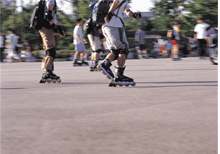
 Summer-Injury-Prevention
Summer-Injury-Prevention
Delightful Weather,
Frightful Injuries
New reports on injuries from sneakers with wheels point up the increased risk of preventable injuries resulting from all kinds of summer recreation, says Dr. David L. Katz, director of the Prevention Research Center at Yale University
By: Dr. David L. Katz*
Last week The Associated Press published a report on injuries related to the use of roller shoes -- sneakers that have wheels in the heels -- like the brand “Heelys.” Relying on data from the U.S. Product Safety Commission, the expose indicated that there are some 1,600 emergency department visits each year in the
 Summer is the season we’re most active -- a good thing -- but also the most likely to injure ourselves in the process. I recall from my years working as an emergency physician how we could count on the frequency of visits for everything from contusions to concussions, bruises to broken bones, to rise with the temperature. Survey data in the
Summer is the season we’re most active -- a good thing -- but also the most likely to injure ourselves in the process. I recall from my years working as an emergency physician how we could count on the frequency of visits for everything from contusions to concussions, bruises to broken bones, to rise with the temperature. Survey data in the
For the most part, trauma related to outdoor recreation is predictable and therefore preventable. In the case of roller shoes, for example, the research suggests a list of common injuries: fractures of the wrist, elbow and hand; dislocations of the elbow; and fracture of the skull. There is protective gear for each of these sites, yet overwhelmingly, these injuries occur in children who are not using it!
So the obvious first line of defense against injuries from roller shoes is to cushion yourself against them. The
Other sports require more selective, but no less important, protective gear. In 20 states, the law requires bicyclists under the age of 16 to use helmets. With or without such laws, anyone attached to their head should adopt the practice! According to the National Highway Traffic Safety Administration, helmets can prevent more than 85 percent of biking-related head and brain injuries, and are the single most effective strategy for preventing fatalities from bike crashes. Much the same is true for horseback riding.
Another simple strategy for keeping you and your children injury-free this summer is to be attentive to your ability level. Most injuries associated with roller sports occur in beginners; in the study of roller shoes, 20 percent of the injuries happened at the very first use. So start any new activity slowly, and learn your ability before testing it too severely.
Similarly, be careful about any sudden, radical change in your activity pattern or level. The risk of injury is compounded if you are deconditioned and suddenly push your body past its tolerance. There is also risk in rushing into a sport or activity before learning about its particular challenges and dangers. Take time to figure them out.
A long-term strategy for avoiding injuries is to stay in shape year round. Activity year round helps keep muscles strong and limber, thereby reducing the risk of crashes and falls, and improving the outcome when they occur. Year-round activity also helps to build and maintain peak bone density -- another defense against fractures.
Always be sure to choose a sensible location for your exercise. Traffic and crowds increase the likelihood of injury from biking, skateboarding and skating. Rough or wet surfaces increase the risk of falls and crashes. If bad weather prevents you from safely getting outdoor exercise during the winter, find an indoor alternative.
Members of The American Academy of Orthopaedic Surgeons are at the ready with casts and splints, rods and screws should we need them. But they also generously offer up a wealth of useful advice so that fewer of us will require their services. Take advantage of their attempt to put themselves out of business by visiting http://orthoinfo.aaos.org/ and click on “Injury Prevention.” These simple precautions can help you preserve summer fun while avoiding the emergency room.